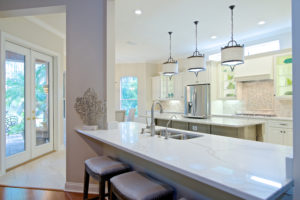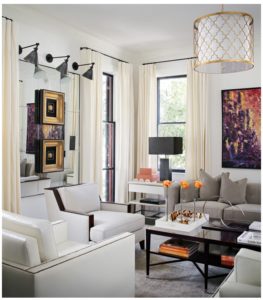Lighting a space can be daunting if you don’t know the basics of functionality and form. While it does not have to cost a fortune to light a space, you can end up overspending on lighting if it is not done correctly.
It is important to set the mood in your space. Is the space to be serene, playful, loud, or serious? Think about what the space exudes. Mood lighting highlights features of items and gives you a feeling of texture and important themes in the space.

Now that you’ve thought about the activities that take place in each of your rooms, it’s time to create a lighting plan. Structure the lighting to meet multiple demands of each space. You need bright light to clean your kitchen, but if you’re having a party, the kitchen lighting level should be able to soften.
Let’s take a look at three ways to illuminate your space when working on your lighting plan: general lighting, task lighting, and accent lighting. The best outcome is to utilize all three types of decorative lighting in your space. You’ll gain maximum impact and illumination.
GENERAL LIGHTING
General, or ambient, lighting illuminates an entire space for visibility and safety. Light bounces off walls and ceilings to cover as much area as possible. General lighting can come from lights that have upward illumination towards the ceiling like scones and torchiers. It can also come from lights that cast downward illumination from a wall or ceiling. These type of lights include recessed (canned) lights and track lights. Some lights, such as table and floor lamps, are both up- and down-lights because they cast light toward both the ceiling and the floor.
TASK LIGHTING
Task, or work, lighting is used in smaller areas where more intense light is needed. Task light should be three times as bright as general lighting. Over
Task lighting examples are recessed lights, track lighting, pendants, table or floor lamps, and under-cabinet lighting strips.
ACCENT LIGHTING
Accent lighting creates a focal point of brilliant shimmer to highlight artwork, sculptures, and outstanding architectural features. Make sure to use a bulb that’s no more than three times as bright as the surrounding general light. The light fixture should be positioned so that the light does not block your line of sight. This position helps to ensure that no glaring reflections bounce back.
Finally, make sure to aim the beam of any track lighting at a 30-degree angle from the vertical to prevent glare and hot spots. This angle will better highlight a wall washing (lighting a non-textured wall) or a wall grazing (lighting a textured wall).
SCALE
Now you have decided on the lighting plan, it’s time to look at scale. A good rule of thumb for picking the right size chandelier is to measure the length and width of the room and add the figures together. For example, a 10 x 12 room = a 22 inch diameter chandelier. The exception is for a dining room chandelier. In this case, chandeliers above dining room tables should have a diameter of 1/2 to 2/3 the width of the table for the best design and lighting effect. Finally, it is also important that your new chandelier emit the correct wattage. The formula for calculating the chandelier wattage is to take the room size, in this case we’ll use the 10 x 12 room, and multiply the numbers together. This gives us 120. Multiply this figure by 1.5 and you’ll have the total wattage needed for a 10 x 12 room which is 180 watts.
There are endless lighting options in today’s market. It may be best to consult a lighting expert or an interior designer to ensure your lighting reflects your lifestyle. It’s time to light it up!

